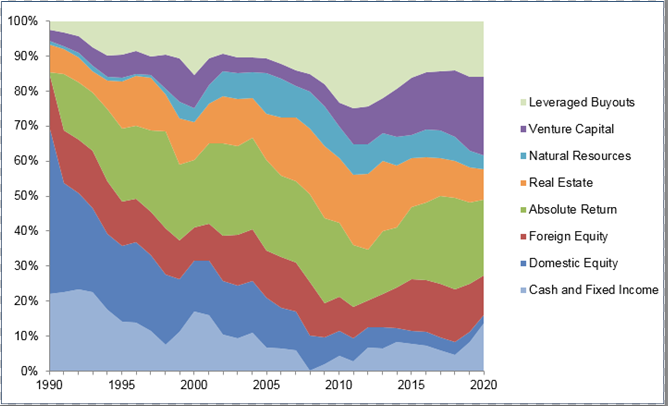Alternatives: what are they, why they’re important and how Saltus use them
If any of our readers looked at the asset allocation tables of a typical institutional or retail portfolio anywhere in the world today, we think that they would be surprised to see how similar they all are. Regardless of who you are or where you lived, investments would be almost entirely distributed across the three mainstream asset classes of stocks, bonds and cash. However, usually tucked away in the corner of a portfolio, there should also be a small portion of the asset allocation given over to a mysterious group labelled as ‘alternatives’. This article intends to explore this often misunderstood part of the investment world and perhaps show that, in the end, they are not so mysterious after all.
The simplest way to think of alternative investments is to classify them as anything that isn’t a conventional ‘buy and hold’ stock, bond or cash position. By conventional, we mean something that is unleveraged, easily priced and usually dependent for a large part of returns on the overall market going up, rather than the individual position itself. The alternative world can then be thought of as everything else, covering a vast array of familiar and unfamiliar assets.
For example the property, commodities and private company markets are usually thought of as the main alternative asset classes. Although they are all familiar enough (housing, oil and the family business being examples in each category) they do bring with them additional features which conventional assets don’t have, such as complexity, illiquidity or the use of borrowed money, also known as leverage. These factors complicate matters when considering the potential risk/return profile of an investment to the extent that it seems to put off the majority of investors from making alternatives a meaningful part of their portfolios.
However these additional features are, in essence, also exactly what makes the alternatives world so attractive to those professional investors who are prepared to put in the work, as they offer up the tantalizing prospect of both additional returns and low correlation with mainstream assets.
There are many other types of alternative investments, outside of the familiar property, commodity and private asset segments. The most recognisable of these, such as art, wine or classic cars, also happen to be much smaller in size and, dare we say it, often carry more entertainment value than anything else. By far the biggest, most useful and widespread of other alternative investment possibilities lie in the derivatives market, where futures, options, swaps and forward contracts allow a manager to take on or offload portfolio risks in a very targeted manner. The breadth of what can be traded is quite staggering and the depth of the markets also huge, totalling over $12trn in gross value in 2021*.
As the name implies, the derivative instruments are nothing more than a focussed way to access returns or reduce risk in the major asset classes. Everything from interest rates to inflation to equity market uncertainty has a derivative investment available which can be used to reflect an investment opinion in a portfolio. Although the maths behind calculating the fair value of a contract can occasionally be complicated, the underlying asset itself is familiar and the contract is simply just another way of transferring risks between willing counterparties.
This point about using alternative strategies to manage the threats and opportunities of investment life has been understood for centuries, even millennia. Babylonian kings first codified the forward contracts, stipulating which goods had to be delivered for an agreed price at a future date as far back as 1750 BC. The Ancient Greeks took out options on olive harvests. Hedging ones bets was a phrase and strategy in use 250 years before the modern hedge fund began life in the late 1940’s. However, for most institutional investors the idea of not straying too far from mainstream assets and styles was so deeply embedded that it wasn’t until the early 2000’s that the stellar returns from the Yale University fund shone a spotlight on exactly what investing in alternative strategies could bring.
Under the tutelage of David Swenson and Dean Takahashi, the Yale ‘Endowment Model’ of investing, took advantage of the universities long term time horizons, to embrace complexity and illiquidity by investing in private assets and various hedged strategies, alongside more traditional stocks and bonds.
The asset allocation graph for the Yale portfolio below shows the shifts occurred over the last 30 years. Beginning with over 80% assets allocated ‘traditionally’ in 1990 and ending with only c. 25% invested that way by 2020, the rest having been moved into property, commodities and private market strategies (i.e. alternatives). The result of this asset allocation shift, combined with the skill of the managers Yale invested alongside, delivered returns of c.14% CAGR, a whopping 4x that of the peer group over the same period.**

The power of the thinking behind the Endowment Model of investing and it’s real (after inflation) objectives, had a deep impact on Saltus at our formation and it’s core tenets are very much in the DNA of investment process today. We have a long heritage in working with traditional and alternative assets, taking the view that an unconstrained approach to investing offers us the best chance or delivering real returns for clients.
We are well aware that there is no magic bullet in investing, but also have always thought that spreading investments across as wide a set of asset classes, geographies and styles as possible, was nothing more than common sense. It is, ultimately, nothing more than seeking diversification of portfolio risk, and one doesn’t need to be a market professional to know that it is usually best not to put all ones investment eggs in one or two baskets.
This thinking is reflected in our multi asset class portfolios today, with, for example, a middle risk client holding roughly 30% exposures to alternative strategies, alongside the more recognisable stock, cash and bond holdings. These investments cover the simplest of alternatives – gold, oil, soft commodities and ground rents in the property sector – to the more sophisticated strategies in private debt, convertible bond arbitrage and interest rate trading.
We have always felt that strategically it made sense to invest in this manner and would suggest that today, as we write, it makes tactical sense as well, given the high correlations between mainstream asset classes. The major categories of alternative investing are very familiar to all and have been attracting capital for millennia. The derivative routes of accessing investments are nothing more precise, targeted way of gaining (or losing) exposure to risks in familiar underlying asset classes. There is nothing mysterious in the motives for using these tried and tested investment tools either, as seeking diversification benefits is the day job of your investment committee. Perhaps the only mystery about alternatives is why they don’t yet form a bigger part of all portfolios. We will leave that to others to explain.
** 2021 Yale endowment report, P.13
Article sources
Editorial policy
All authors have considerable industry expertise and specific knowledge on any given topic. All pieces are reviewed by an additional qualified financial specialist to ensure objectivity and accuracy to the best of our ability. All reviewer’s qualifications are from leading industry bodies. Where possible we use primary sources to support our work. These can include white papers, government sources and data, original reports and interviews or articles from other industry experts. We also reference research from other reputable financial planning and investment management firms where appropriate.
